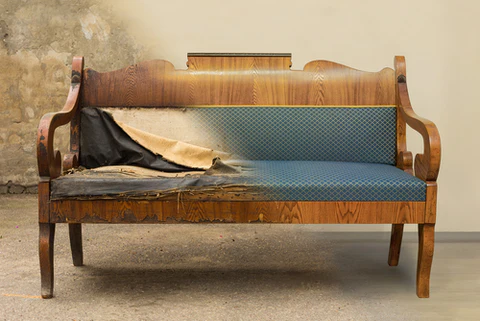Understanding when and how to get rid of old furniture when it has reached the end of its useful life is crucial for maintaining a safe and comfortable home environment. Furniture does not age uniformly; factors such as usage level, environmental conditions, and material quality play a role. A telltale sign that your couch, chair, or table is past its prime is when its structural components falter. For example, the support beams might creak ominously each time you sit, or the table legs wobble precariously, creating a potential hazard for anyone using them. Aesthetic deterioration, such as persistent fabric stains or chipped wood finishes, indicates that a piece may no longer serve its intended purpose effectively. These cues necessitate a frank assessment of whether repairs can rejuvenate the item or if it’s time to replace it altogether.
Assessing Furniture Condition: A Practical Guide
Structural Integrity and Safety
Prioritizing structural integrity ensures that your furniture remains safe, which is paramount. Frequent inspections can uncover wear and damage that might not be immediately visible but could lead to larger issues if left unaddressed. Tightening loose screws, reinforcing weak joints, or replacing broken components can temporarily extend the life of your furniture. However, it’s crucial to recognize the point at which these repairs become economically inefficient compared to replacement. Identifying issues early lets you plan for replacements, ensuring functionality and safety are never compromised.
Comfort and Aesthetics
Comfort should be at the heart of any furniture assessment. Over time, the springs and padding in chairs and sofas degrade, leaving them less supportive and inviting. Moreover, aesthetic wear, such as fading upholstery or scratched surfaces, can detract from your home’s overall visual appeal. When evaluating your furniture, consider how well it complements your interior style and how enjoyable it is to use daily. If your furniture no longer meets these criteria, it might be time to explore new options that enhance your living area’s functionality and beauty.
Emotional Attachment: When Sentiment Stalls Progress
Emotional attachment often complicates the decision to let go of old furniture. These pieces are often tied to nostalgic memories or significant life events, as tangible reminders of cherished moments. However, it’s important to separate emotional value from practical utility. Holding onto items that no longer serve your current needs can obstruct home improvements and limit your ability to adapt your living space to future circumstances. Consider creating a balance by repurposing sentimental items into other functions or locations, preserving their essence while accommodating more modern and functional replacements in key living areas. Capturing memories by taking photographs of treasured items can provide lasting emotional satisfaction without occupying valuable physical space.
Sustainable Options for Letting Go
When the time comes to dispose of outdated or unusable furniture, opting for sustainable solutions is both environmentally responsible and often socially beneficial. Donating furniture to charitable organizations supports community members in need and promotes reuse and recycling. Many organizations make the donation process seamless by offering pickup services, sparing you the trouble of arranging transportation. For items beyond donation, recycling offers an excellent alternative. Specialized facilities can disassemble furniture to recover valuable materials like wood, metal, and fabric, fostering a circular economy that reduces landfill waste. Recycling centers can guide how best to prepare your furniture for eco-friendly disposal, reinforcing the importance of sustainability in every aspect of home management.
Upcycling: A Creative Solution
Upcycling is a creative approach that breathes new life into old furniture, making it both an art form and an eco-conscious choice. Through upcycling, the limits of imagination are tested by repurposing materials and crafting innovative upgrades. A bedside table can be transformed into a stylish pet bed, or a wooden pallet can become an accent wall feature. This method reduces waste and allows for personalized and unique home decor solutions. Anyone can engage in upcycling with the help of online trend tutorials and workshops, empowering even the least experienced DIY enthusiasts to contribute to sustainability creatively.
Space Optimization and Lifestyle Changes
Your furniture should complement, not constrain, your lifestyle. As life changes—whether it’s growing families, home downsizing, or simply a change in aesthetic preference—furniture must adapt too. Consider multifunctional furniture to efficiently use space and promote a harmonious interior environment. Flexible solutions, such as extendable tables, sofa beds, or wall-mounted desks, offer utility without sacrificing style or comfort. Evaluating how your current furniture meets the demands of your lifestyle is crucial for maintaining a dynamic, versatile home setting, ensuring that your living spaces continue to serve you optimally as your needs evolve.
How to Prepare Furniture for Disposal
Preparing furniture for disposal involves a thoughtful process to simplify its transition out of your home. First, thoroughly clean items to enhance their appeal to potential new owners through donation or sale. Remove all personal belongings and ensure everything is in good condition to avoid issues during pickup or drop-offs. For items heading to recycling, disassembling the furniture into components like wooden slats, metal frames, or fabric sections facilitates the process, ensuring valuable materials can be processed efficiently. Hazardous materials, such as electronics or batteries, should be disposed of following local regulations to prevent environmental harm. Employing these practices supports convenient transportation and aligns with eco-friendly disposal goals, reflecting a commitment to sustainability and community welfare.
Conclusion: Mindful Decisions for Furniture Transition
Letting go of old furniture is a journey that intertwines practicality, sentiment, and environmental consideration. Thoughtful assessment of the condition and utility of items ensures that your home remains safe and inviting while embracing sustainability. Exploring options such as donations, recycling, and upcycling extends the life and purpose of furniture, contributing positively to the planet and your community. These insights enable informed decision-making, fostering a living space that evolves alongside your lifestyle while preserving cherished memories. Ultimately, finding harmony between emotional heritage and contemporary needs nurtures a dynamic home environment filled with comfort, style, and responsibility.





